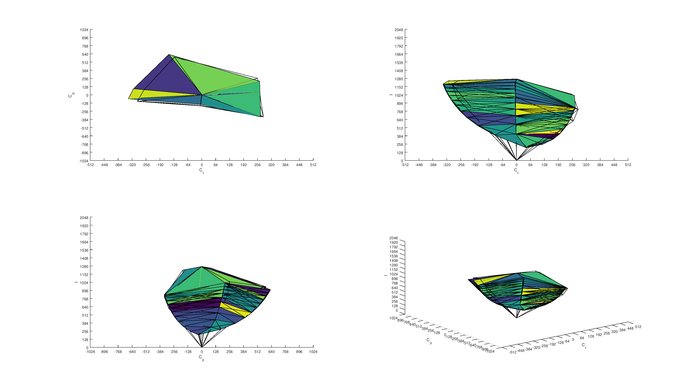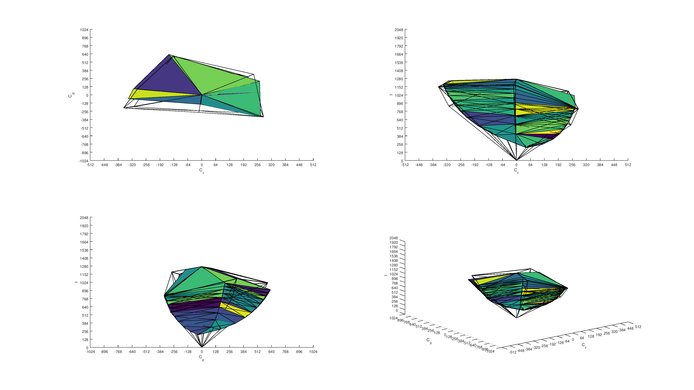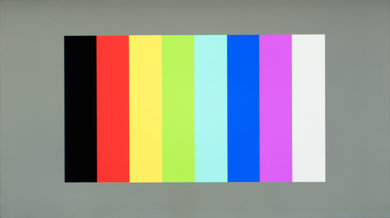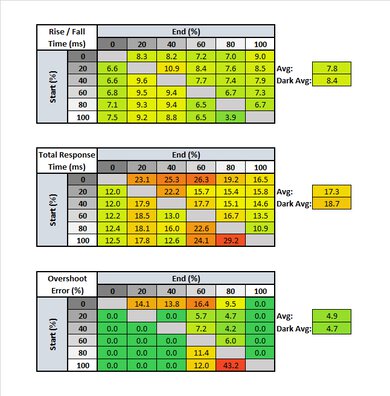The HP 27f is a basic entry-level gaming monitor that delivers decent overall picture quality. The 27" IPS screen delivers great wide viewing angles, and it has great accuracy out of the box. It also has very good gaming features, including excellent low input lag and AMD FreeSync support. Unfortunately, it has a fixed stand with bad ergonomics, and it has mediocre dark room performance.

We buy and test more than 30 monitors each year, with units that we buy completely on our own, without any cherry-picked units or samples. We put a lot into each unbiased, straight-to-the-point review, and there's a whole process from purchasing to publishing, involving multiple teams and people. We do more than just use the monitor for a week; we use specialized and custom tools to measure various aspects with objective data-based results. We also consider multiple factors before making any recommendations, including the monitor's cost, its performance against the competition, and whether or not it's easy to find.
Our Verdict
The HP 27f is a decent monitor for most uses. It has a fast response time so fast-moving objects in movies and games look good and have only slight motion blur. It has excellent low input lag and supports AMD FreeSync, great for gaming. Unfortunately, it is limited by the 1080p resolution, which isn't great for multitasking or for working on detailed projects. It also has a fixed stand with bad ergonomics, so it is hard to place in an ideal viewing position.
- Accurate image out of the box.
- Low input lag and FreeSync support.
- Fixed stand with bad ergonomics and no VESA mount.
- Mediocre dark room performance.
The HP 27f is a decent monitor for office use. The image remains accurate when viewed at an angle, which is great for sharing work with nearby coworkers. The HP 27f has decent peak brightness, and great reflections handling, so you shouldn't have any issues in a bright office. The 27" screen is a great size, but the 1080p resolution is less than ideal for multitasking. Unfortunately, it has a fixed stand with bad ergonomics, so you may have a difficult time adjusting the monitor to an ideal position, and it can't be VESA mounted.
The HP 27f is a decent monitor for gaming. It has a great response time, with only a short blur trail behind fast-moving objects. It has excellent low input lag, and it supports AMD FreeSync, which is great. The 75Hz refresh rate is great for casual gamers but may be disappointing to more advanced gamers. Unfortunately, the 1080p resolution doesn't provide a very immersive gaming experience, and it has mediocre dark room performance.
The HP 27f is alright for multimedia. It has a large, 27" screen and great wide viewing angles, good for sharing the latest trends with a group of friends. Motion looks good thanks to the fast response time, so there's only a slight blur trail behind fast-moving objects. It is limited by the 1080p resolution and mediocre dark room performance though.
The HP 27f is okay for media creation. The 27" screen is a good size, but the 1080p resolution limits how much of your project you can see at a time. It has excellent s.RGB coverage, but the Adobe RGB coverage is less than ideal for professional photo and video editing. The fixed stand also makes it difficult to place the monitor in an ideal viewing position.
The HP 27f doesn't support HDR.
Changelog
- Updated Oct 19, 2022: Compared the SDR color gamut to the recently-reviewed LG 27MN60T-W.
- Updated Jul 02, 2021: Changed height adjustment result from 'N/A' to '0' to match our methodology.
- Updated Jul 13, 2020: Converted to Test Bench 1.1.
- Updated Jan 15, 2019: We tested the monitor's compatibility with NVIDIA's new FreeSync driver. See our full investigation into NVIDIA's FreeSync Drivers here.
Check Price
Differences Between Sizes And Variants
We tested the 27" 27fw 3KS64AA, and it is also available in 22", 23", 24", and 25" models. We don't know what other differences there may be for the other sizes, and we don't know if our review is representative of these sizes.
Update 03/18/2019: The product SKU listed was incorrect, it was for the 27f model (2XN62AA).
Update 09/25/2019: There's an international variant of the 27fw, product code 4TB31AA. We don't know if it performs the same, but it does have built-in speakers.
The HP 27fw is also known as the 27f. The only difference is the color of the back panel. The HP 27f has a black back, the 27fw has a white back.
If someone comes across a different type of panel or if their HP 27fw doesn't correspond to our review, let us know and we will update the review. Note that some tests such as the gray uniformity may vary between individual units.
| Model | Size | Resolution | Refresh Rate | Notes |
| 22f | 22" | 1920x1080 | 75Hz | FreeSync |
| 23f | 23" | 1920x1080 | 75Hz | FreeSync |
| 24f | 24" | 1920x1080 | 75Hz | FreeSync |
| 25f | 25" | 1920x1080 | 75Hz | FreeSync |
| 27fw | 27" | 1920x1080 | 75Hz | FreeSync, White Back |
| 27f | 27" | 1920x1080 | 75Hz | FreeSync, Black Back |
| 27Q | 27" | 2560x1440 | 60Hz | FreeSync |
The 27fw we tested was manufactured in July 2018.
Popular Monitor Comparisons

The HP 27f is a decent budget monitor with great gaming features. See our recommendations for the best monitors under $200, the best budget gaming monitors, and the best gaming monitors under $200.
The HP 27F is overall much better than the MSI Optix G27C for most uses. The 27F has an IPS panel, so the image remains accurate when viewed at an angle, great for quick co-op gaming sessions, or for sharing your work with a nearby coworker. The 27F also has much better dark room performance. For gamers, it depends on what's the most important thing to you, as the G27C has a much faster refresh rate and wider VRR range.
The HP 27F and the Samsung CF398 use different types of panels, each with their strengths and weaknesses. The 27F has an IPS panel, so the image remains accurate when viewed at an angle. The CF398 has a VA panel, and it delivers better overall dark room performance. The HP 27F also has a slightly faster refresh rate, although it isn't a significant difference.
The Dell P2417H is a bit better than the HP 27F. The P2417H is a slightly smaller screen with a 60Hz refresh rate, and no VRR support, but it has significantly better ergonomics, making it easier to place in an optimal viewing position, or for a multi-monitor setup. The P2417H is also more versatile than the HP 27F, with HDMI, DisplayPort, and VGA connections, and it can be used as a USB hub.
The HP 27F is slightly better than the HP 27Q. The 27F has a slightly faster refresh rate, and much lower input lag, great for gaming. The HP 27Q has a better 2560x1440 resolution, which allows you to see more fine details in games, and makes it easier to multitask.
Test Results

Update 07/02/2021: We previously had incorrectly listed the Height Adjustment as 'N/A' as opposed to '0'. The review has been updated to reflect this change, as the Ergonomics score has dropped slightly.
The HP 27f has a fixed stand that can only tilt. There is no height adjustment, and it can't swivel or rotate.
The back is very simple, with only a slight silhouette of the HP logo. All of the inputs face out of the back, and unfortunately, it can't be VESA-mounted. There's also no cable management.
The HP 27f has decent build quality. The monitor itself is well-built, but the stand does have some issues. It isn't very solid, and doesn't support the display well; even the impact from typing causes the monitor to wobble significantly. Overall, it's similar to the HP 27Q, but the stand is slightly worse.
The HP 27f has mediocre contrast, very similar to the Dell P2417H, and about average for an IPS monitor. Unfortunately, blacks tend to look gray in a dark room.
There's no local dimming feature on this monitor. The video is for reference only.
Decent peak brightness, with no variation between scenes, which is great. There should be no issues using the monitor in a bright room.
HDR isn't supported on this monitor.
The HP 27f has decent horizontal viewing angles, typical for IPS monitors. Colors remain accurate up to about 40°, and then they rapidly oversaturate. The brightness drops gradually as you move away from the center but remains within acceptable limits up to 47°, and the black levels remain accurate at any viewing angle.
The HP 27f has very good vertical viewing angles. Within 25°, the image remains accurate, but beyond that, it degrades rapidly as colors quickly become over saturated and the brightness drops.
Out-of-the-box, the HP 27f has great accuracy. The white balance is excellent, with very few issues. Color accuracy is good, but there are small inaccuracies in almost every color, although they are minor enough that most people won't notice them. Gamma doesn't follow the target curve, with some scenes over brightened, and some over darkened.
After calibration, the HP 27f has excellent accuracy. The white balance error and color error are nearly entirely corrected. Gamma follows the target curve almost perfectly.
You can download our ICC profile calibration here. This is provided for reference only and should not be used, as the calibration values vary per individual unit even for the same model due to manufacturing tolerances.
The HP 27f has a very good color gamut. It has excellent coverage of the standard s.RGB color space, but only decent coverage of the wider Adobe RGB color space, which is less than ideal for professional photo or video editing. If you prefer something similar with a slightly wider color gamut, then consider the LG 27MN60T-W.
s.RGB Picture Mode: Custom
Adobe RGB Picture Mode: Custom
Very good SDR color volume. It has excellent color volume in the s.RGB color space, but it can't produce deep, dark colors very well, and like most monitors, it can't produce bright blues or magentas.
In the wider Adobe RGB color space, it has good color volume. Like with s.RGB, it is limited by the mediocre contrast ratio, so it can't produce deep, dark colors very well.
HDR isn't supported on this monitor.
HDR isn't supported on this monitor.
There are no signs of image retention on the HP 27f, even immediately after showing our high contrast static test image for 10 minutes.
Great reflections handling, similar to the HP 27Q and ViewSonic XG2402. There should be no issues using this monitor in a bright room.
Response Time Level 1
Response Time Level 2
Response Time Level 3
Response Time Level 4
Response Time Level 5
The monitor has a great response time. There are five overdrive settings, and each setting adds a bit more overshoot. The best Response Time setting is 'Level 2', as this mode improves the response time the most without adding noticeable overshoot.
The HP 27F doesn't have an optional Black Frame Insertion feature. If you want a monitor that does, check out the Samsung Odyssey G5.
Update 01/15/2019: Unfortunately, the HP 27F does not support NVIDIA's FreeSync implementation, as it doesn't have a DisplayPort connection, which is required.
At the native resolution of 1080p, the HP 27f has a decent 75Hz refresh rate. At non-native resolutions, only 60Hz is supported. This shouldn't be an issue for most people though, as most graphics cards will upscale without you even knowing. Many websites advertise the HP 27f as a 60Hz monitor, but 75Hz is supported out of the box with no additional steps, and it is fully supported with no dropped frames. On NVIDIA cards, the 1920x1080 resolution must be selected from the list of 'PC' resolutions in the NVIDIA Control Panel.
It supports FreeSync over HDMI, which is great. To enable FreeSync, select the 'Gaming - FreeSync' Picture Mode.
Excellent low input lag, great for casual gamers. The non-native resolution was tested at 60Hz, as that is the only refresh rate available in non-native resolutions. The input lag is much better than the HP 27Q.
The HP 27f has a great 27" screen, which allows you to see more fine details in your work, but the 1080p resolution may be limiting to some people. It doesn't provide a very immersive gaming experience, and it isn't ideal for multitasking.
If you want a similar monitor with a higher resolution, check out the Dell S2721D.
There's no 3.5mm jack for connecting speakers or a headset, which is uncommon.
The HP 27f has very few additional features. It does not support HDR, and has no built-in speakers. There are a few image adjustment options that can help when gaming, including:
- Dynamic Contrast: Automatically adjusts the contrast on a per-scene basis.
- Black Stretch: Adjusts the gamma to make dark objects in dark scenes easier to spot, similar to the Black Stabilization feature found on other monitors.













































